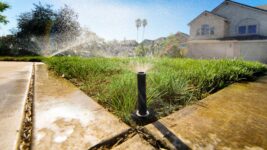
Sprinkler break? Don’t be fooled by all the rain

If you are one of the people who say it’s summer, so I can turn off my sprinklers, this column’s for you. In spite of the fact that we are still in the rainy season, signs of water stress can appear quickly on lawns this time of year.
This situation occurred on Marco last week. While this has been a fairly wet summer, we have also had dry periods between rainstorms. And this can happen at any time during the hot summer months. Water is needed in large quantities by a lawn. And it is required more frequently in the hot spring and summer than during the winter. A good example of this process is how quickly the rain waters recede from our area roads after summer rainstorms (as long as it isn’t high tide). If you turn your sprinklers off after one of these rainstorms, be sure to turn them back on if there are no more soaking rains within four or five days. This is especially important if you have new sod or shrubs in areas. These plants have very shallow roots and our soil is sandy.
Water comprises 80 to 90 percent of the fresh weight of grass and it also plays a fundamental role in the plant metabolism. Only one percent of water absorbed by plants is utilized for metabolic activity. The majority of water absorbed is used for transpiration. This is a plant process in which water is absorbed by the roots, passed through the vascular system, and exited from the plant via the stomata into the atmosphere. Transpiration helps maintain plant temperatures by cooling through the latent heat of vaporization. Similar to our own perspiration. The water absorbed by the plants in the transpiration process also brings nutrients from the soil into the plant. This is one of the reasons the plants look so much healthier after a good rain.
The amount of water transferred into the atmosphere by evapotranspiration from turf surfaces is governed by a number of environmental factors. Sunlight, relative humidity, temperature, wind and available soil moisture are all controlling elements. Minimal ET rates occur when there are dark, cloudy days with high relative humidity, low temperatures and no wind. Maximum ET rates occur on bright sunny days with low humidity, high temperatures and high winds.
According to a table computed by the United States Department of Agricultural Soil Conservation Service June through September have the highest evapotranspiration rates. These are months which also have the highest irrigation requirements if we don’t have adequate rains. Don’t be misled by light summer rain showers. Often these rains only wet the soil surface and evaporate rapidly. A general rule used in Florida is to apply 3/4 to 1 inch of water one to two times a week in summer.
It is true that too much water can cause damage just like too little water. Most people do not pay close enough attention to their lawns to allow for the “Water on Wilt” method. The result is a lawn which goes into water stress when too little water is applied during periods when we don’t have adequate rainfall. This results in populations of chinch bugs in the dry areas and the need to apply more insecticides to prevent damage. Disease can also become a problem in these stressed areas and once again chemicals will be needed to correct the problem. Good horticultural practices always help diminish the need for more chemicals in our environment.
The best remedy is to have a rain-stat or sensor installed. It will pay for itself the first summer you install it. Installed on the edge of the house, above the drip line, it is a device that is wired to the sprinkler timer and will automatically turn the system off when there has been adequate rainfall. As the wick dries (as the soil would dry) it allows the system to run again. These devices are required by law on all houses. Every home should have one. Call your sprinkler repair company and have a rain sensor installed today and then let it do its job.
There are also many new smart irrigation systems on the market. These systems sense the need for water in various ways and only allow the system to run if the need is there. While the initial investment may be more than the conventional system it will surely pay for itself in the long run.
Whatever method you choose just be sure that you do not allow the lawn to wilt to the point of damage or over water. As mentioned above, both will cause problems that will in turn require the need for more chemical use and that is always a bad thing for the environment.
More:Gardening: Help fight the spread of invasive vegetation
And:Calusa Garden Club: Members work, play on Marco
Also:Gardening: Welcome to summer in the sub tropics
Peter and Eileen Ward have sold Greensward of Marco after 40 years in the lawn and landscape business on Marco Island. You can reach Eileen with comments or questions on her columns via email at Gswdmarco@comcast.net or call 239-269-0192.



